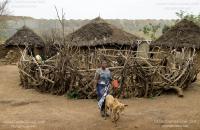| BACKGROUND AND IMMEDIATE CONTEXT: Civilian Uprising against Barrick Gold in Tanzania Mine security shoots young man, villagers respond by destroying $7 million in equipment by Sakura Saunders, editor protestbarrick.net, http://www.dominionpaper.ca/articles/2385 December 24th, 2008 | ||
Last week, reports surfaced in the mainstream press that thousands of villagers had raided a gold mine in Northern Tanzania, setting fire to $7 million* worth of mine equipment. Most reports blamed problems with crime in the area, calling the intruders "gold-seekers." While the spokesman for Barrick Gold** Tanzania, Teweli Teweli, describes these villagers as "well-organized groups" who attacked the pit following the blasting of high-grade ore, others paint Barrick as the aggressor in this event, citing immediate and historic causes that have been largely ignored by the international community. According to several witnesses, the immediate cause of the civilian uprising was the killing of a young man named Mang'weina Mwita Mang'weina. Human rights lawyer Tundu Lissu, who represents many of the villagers, explains that Mang'weina and some friends were engaged in an argument with Barrick security when one of the guards shot Mang'weina, who was unarmed at the time. This incident caused an uproar within the community, which immediately took up stones, overpowered mine security (who then fled), and attacked the mine, setting fire to millions worth of equipment. Mang'weina himself is a part of the legacy of the North Mara mine. He was one of the thousands of unemployed locals in the area, angry over the mine's recent history of forced displacement, loss of livelihoods, human rights abuses and ongoing repression. He is the seventh person killed at the hands of mine security since July 2005, when the killing of a local boy sparked a similar uprising that resulted in the destruction of mine equipment and the subsequent detention of over 200 villagers.*** Eyewitnesses to the 2005 killing told The Guardian (Tanzania) that "the boy who was shot dead was walking past the company premises when company security guards, suspecting him of stealing oil, stopped him. When the boy failed to heed the order, the guards called the police who, before even questioning him, shot him in the chest." Not one year later, security guards employed by Barrick Gold allegedly shot � five times in the back � another villager who was alleged to have illegally entered the mine complex, bringing the death toll to six. According to Lissu in a letter written in June 2006:
Calculating from media reports, Lissu estimates that over 10,000 artisanal miners, peasant farmers and their families were kicked out of the area to make way for the North Mara mine in 2001. Since that time, there has been ongoing tension between the mine and the local communities. According to Allan Cedillo Lissner, a Toronto-based photojournalist who recently interviewed families surrounding the North Mara mine, "Ongoing conflict between the mine and local communities have created a climate of fear for those who live nearby." Since the mine opened in 2002, one family told Lissner that they live in a state of constant anxiety because they are repeatedly harassed and intimidated by the mine's private security forces and by government police. "There have been several deadly confrontations in the area and every time there are problems at the mine, the Mwita family say their compound is the first place the police come looking. During police operations the family scatters in fear to hide in the bush, 'like fugitives,' for weeks at a time waiting for the situation to calm down," Lissner explains. The Mwita family explained that they used to farm and raise livestock, telling Lissner that "now there are no pastures because the mine has almost taken the whole land ... we have no sources of income and we are living only through God's wishes. ... We had never experienced poverty before the mine came here." They also told Lissner that they would like to be relocated, but the application process has been complicated, and they feel the amount of compensation offered was merely "candy." According to Tanzanian journalist and community advocate Evans Rubara, this latest uprising "is a sign to both the government of Tanzania and the International community (especially Canada) that poor and marginalized people also get tired of oppression." He hopes that the recent conflict will inspire Barrick "to start another strategy that will bring a good and constructive relationship with the local communities by implementing programs that do not enhance more looting and belittle Tanzania, leaving thousands in destitution." Since this most recent uprising, dozens of villagers have been arrested. According to Lissu, who plans to represent those arrested, "They have arrested dozens of people; [Barrick is] on a war path; these people have been denied bail, they are targeting the youth and repression is on." Lissu also spoke about reports of weapons making their way into the North Mara area. "Two days ago, we got information that [Barrick is] importing weapons: a ton and a half of tear gas, and hand grenades were transported to the mine on Thursday. The hand grenades were seized by customs on the way to the North Mara Gold Mine, but have since been let through," he told ProtestBarrick.net on the phone from Tanzania. Sakura Saunders is an editor for protestbarrick.net, an all-volunteer news site that networks organizations and community groups organized against Barrick Gold around the world. * On December 17, 2008 Barrick Gold said it had revised down the damage to its North Mara Mine in Tanzania during an attack last week to about $7 million from an earlier estimate of $15 million. ** In January 2006, Barrick Gold merged with Placer Dome, who previously owned the North Mara mine. *** By mid 2006 all of the villagers detained after the 2005 uprising had been released by the courts after the authorities failed to prosecute them. |



